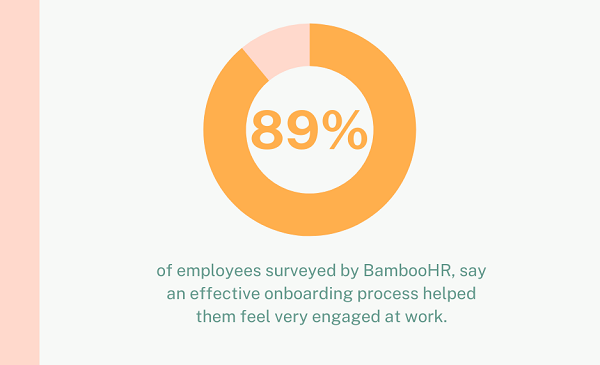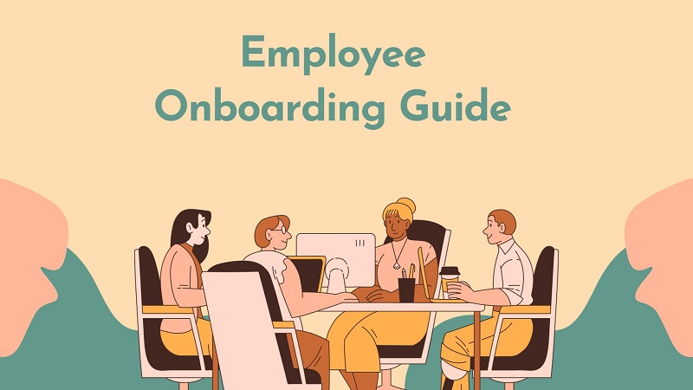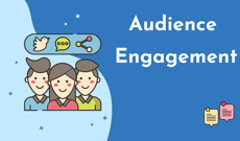When an employee starts working at a new place, they can often feel anxious and overwhelmed, just like a student entering a new school. However, there's no need to revisit these stressful teenage experiences. Here’s where a thought-out and structured employee onboarding process comes into play as an essential element for the well-being of the employees and the overall success of the company. Such a process can make the first days at work smooth and comfortable, laying the foundation for an efficient employee-employer relationship.

According to the employees surveyed by BambooHR, 89% say an effective onboarding process helped them feel very engaged at work. In fact, these employees are 30x more likely to feel overall job satisfaction, compared to employees who feel their onboarding process was lacking.
This way, creating an onboarding process for your company leads to happy employees, job satisfaction, and long-term employee retention. So today we invite you to take a closer look at our step-by-step guide to see what encompasses an employee onboarding process, and how you can get it right. But first, let’s define what an employee onboarding process means.
What is an Employee Onboarding Process?
Employee onboarding is the process of introducing a new employee to a company, making them familiar with their workspace, company policies, and the company culture. The term involves every step required to equip the employees with tools and techniques that will help them become productive members of the team, from initial introduction and team meetings to training sessions.
Just remember that the purpose of an onboarding period is two-fold. On the one hand, the traditional goal of employee onboarding is to help new hires start working as quickly as possible and make them feel excited about their work and team. On the other hand, the more recent role of onboarding has been to shape the first impressions new employees have of the company and help them decide if it’s a good fit for them. Integrating HR software solutions in this process not only expedites the initial learning curve but also contributes to creating a positive and efficient onboarding experience. By leveraging these tailored HR software solutions, companies can ensure a smoother transition for new employees, allowing them to dive into their roles swiftly while feeling supported.
Benefits of an Employee Onboarding Process
✨ For the company
- Reputation: a positive onboarding experience can enhance the company’s reputation, making it an attractive place to work.
- Increased productivity: a structured onboarding process helps new employees understand their roles, responsibilities, and expectations quickly, leading to higher productivity.
- Employee retention: when employees enjoy the onboarding process, they are more likely to stay with the company longer.
- Cultural fit: onboarding helps integrate new hires into the company culture, promoting a sense of belonging and alignment with the organizational values. This is especially important when hiring international employees, as it fosters understanding and inclusion across diverse cultural backgrounds.
- Knowledge transfer: employee onboarding helps in the efficient transfer of knowledge and skills, ensuring that new hires are well-equipped to perform their jobs.
- Cost savings: lower staff turnover rates result in reduced costs associated with recruiting, hiring, and training new employees.
✨ For the employee
- Role сlarity: onboarding provides clear information on job roles, expectations, and paths to success.
- Confidence boost: proper training and introduction increase confidence and ability to contribute to the team.
- Job satisfaction: a smooth onboarding experience leads to increased job satisfaction, impacting performance positively.
- Networking: onboarding helps new hires build relationships with colleagues, managers, and leaders, facilitating communication and collaboration.
- Career development: employees can understand the opportunities for growth and development within the organization.
- Organizational commitment: when employees are onboarded effectively, they are more committed to the organization’s objectives and are likely to stay longer.

If you’re wondering, what the document that can help you with the onboarding process is, don’t look further, we’ve got one for you! Yes, you’ve guessed right—it’s an employee handbook. Also known as an employee manual or a staff handbook, it’s a document with job-related information like the employer’s welcome statement, company values, policies, and rules.
The great news is that it doesn’t have to be a boring document no one wants to read—on the contrary, digital technologies allow you to create an engaging interactive handbook with the help of a variety of employee handbook makers. Check out this online employee handbook example, made with FlippingBook.
You can simply upload your PDF to FlippingBook and it will be converted to an online handbook that you can customize to your liking, brand with your company background and logo, and add interactivity to boost engagement.
FlippingBook can also help you create a digital employee onboarding guide for your HR team so that they have all the info in one place and could access and share it anytime on any device. Here's an example of how neat and engaging you guide can look:
If you don't have a PDF yet, check out these free handbook Canva templates that you can design, and then get back to FlippingBook to create employee handbooks right away. What's more, FlippingBook has a convenient integration with Canva that allows you to seamlessly proceed from designing a PDF in Canva to publishing your PDF to FlippingBook, where you can customize it and make it fun and interactive.
And now, let’s delve into the employee onboarding process step-by-step.
Employee Onboarding Process
Step #1: making the offer
Sending an offer letter to the candidate is the first important step of the onboarding process. An offer letter is a great opportunity to channel the fresh excitement and enthusiasm you’ve generated during the hiring process—and it will help you set the right tone for the entire onboarding process.
According to BambooHR’s survey, the new hires who received a highly effective offer letter were approximately 17 times more likely to report feeling emotionally connected to their organization.
Step #2: accepting the offer
Once the employee accepts the offer, the best practice for you will be to schedule a quick call to review the forms, benefits, policies, and set expectations. Keeping the new hires engaged will affirm their choice to accept the offer and make them look forward to joining the company.
Step #3: first day at work
For a new hire, the first day at work can be quite overwhelming. That’s why the HR department needs to create an employee onboarding checklist for the first day to help new employees feel welcomed and at ease. Here are the main points to include:
✔️ Have someone ready to welcome your new hire when they get to the office, for instance, your office manager.
✔️ Give your new hire a detailed office tour and make them aware of their schedule for their first few days.
✔️ Schedule a short welcome meeting at the beginning of the day to share things like welcome packs, security credentials, intranet links, company literature, and anything else your new employee might need to gain a better understanding of the business, and their role within it.
✔️ Teach your new hire about the company culture. There are many opportunities to communicate the company culture during team meetings or share what values the brand carries when giving your new hire company literature, like brand books, or branded merch. 91% of new hires who received an effective introduction to company culture training feel connected to their workplace—compared to just 29% who say their onboarding experience was lacking.
✔️ Take your new hire out for lunch with some of their key team members. Connecting with a new team can be challenging, especially when some of the employees are working remotely, so focus on setting up real and virtual meet-and-greets with one or two important contacts at a time.
✔️ Allow your new hire some alone time to set up their new equipment, set new passwords, and log in to their new accounts.
✔️ Give new hires a welcome kit full of branded merch, such as custom hoodies and office supplies, customized with your company’s brand, colors, and logos. Who doesn’t like some merch, right?
Step #4: first weeks at work
The first day is over, the week goes on, and your new employee is starting to settle in. The next steps of the employee onboarding process are as crucial as ever because these early weeks determine if the employee and your company are a perfect match or not. Here’s what you can do:
- Send out a new hire announcement. Make it nice and cute, ask your new hire about the hobbies and interests they would like to share with their new colleagues and include this info in your introduction.
- Schedule meet-and-greets with collaborators and teams across the company.
- Establish a list of regular tasks, goals for the first year, and key performance indicators.
- Provide information about the growth potential for their specific position or upward mobility at the company in general.
- Provide quick feedback on their initial work tasks and establish management expectations for their performance.
- Check in with them regularly and respond to any questions they have.
- Keep up with your employees by using a workforce management system.
Final Thoughts
By investing in a comprehensive and effective employee onboarding process, you can ensure that new hires are set up for success from day one, leading to a range of long-term benefits for both the employees and the organization. We hope that our guide will help you on this journey, good luck!







